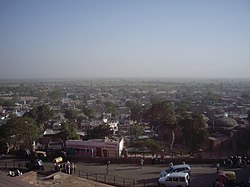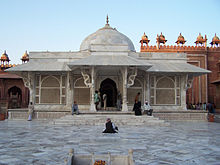Fatehpur Sikri
| Fatehpur Sikri फ़तेहपुर सीकरी |
||
|---|---|---|
|
|
||
| State : |
|
|
| State : | Uttar Pradesh | |
| District : | Agra | |
| Sub-district : | Kiraoli | |
| Location : | 27 ° 6 ′ N , 77 ° 40 ′ E | |
| Height : | 185 m | |
| Area : | 8 km² | |
| Residents : | 32,905 (2011) | |
| Population density : | 4113 inhabitants / km² | |
| Website : | Fatehpur Sikri | |
| View over the city of Fatehpur Sikri | ||
Fatehpur Sikri ( Hindi : फ़तेहपुर सीकरी , Fatehpur Sikrī ) is a city in the Indian state of Uttar Pradesh in India with about 35,000 inhabitants. The former capital of the Mughal Empire was located here at the end of the 16th century . The monuments of the palace district have been under the protection of UNESCO since 1986 and are part of the world cultural heritage of mankind .
location
Fatehpur Sikri is at an altitude of about 175 to 185 m above sea level. d. M. on the eastern edge of the Aravalli Mountains around 36 km (driving distance) southwest of Agra . The border with the state of Rajasthan runs just a few kilometers to the west . The climate is warm to hot; Rain falls almost exclusively in the summer monsoon months.
population
Official population statistics have only been kept and published since 1991.
| year | 1991 | 2001 | 2011 |
| Residents | 25,446 | 28,804 | 32,905 |
Approx. 54% of the population are Hindus and around 45% are Muslims ; the remainder of 1% goes to various religious communities ( Sikhs , Jains , Buddhists and Christians ). As is common in northern India, the male population is around 12% higher than the female.
economy
If the local population had sunk again to a rural-peasant level after the departure of the Mughal farm, a new period in its history began for the place in the second half of the 20th century with increasing tourism.
history
The former capital of the Mughal Empire under Mughal Emperor Akbar I (1542–1605) was built between 1569 and 1574. In 1571 Akbar moved here with his court, but in 1585 he moved the court to Lahore , from where he could better lead his campaigns in northwest India. In addition, the city's water supply was probably inadequate. As an outstanding diplomat and military strategist, he consolidated his newly acquired territories through a policy of religious tolerance in dialogue with representatives of the most important faiths.
Akbar was the first Mughal ruler to marry a Hindu Rajput princess from Amber ( Mariam uz-Zamani ) and abolished the special taxes imposed on all non-Muslims. By gaining the loyalty of local princes , often through marriages, he succeeded in introducing an efficient tax system that eventually enabled him to finance the buildings in Fatehpur Sikri.
Despite his numerous wives, he had no heirs for a long time, so that he was deeply impressed when he received the prophecy of the birth of three sons from Sheikh Salim Chishti , who lives in Sikri , a teacher of the Chishti order - an event that happened within a few years also arrived. Fatehpur Sikri was built in honor of the sheikh.
Royal palace
Diwan-i-Am The main palace and courtyard complex have largely been preserved thanks to extensive restoration work by British archaeologists before India's independence from Great Britain in 1947. The audience hall ( Diwan-i-Am ) in the palace complex , surrounded by arcades and ornate jali grids decorated with semi-precious stones , was the focus of the most important celebrations, the subjects were allowed to address their petitions to the ruler here .
Diwan-i-Khas In the northwest corner of the Diwan-i-Am , a simple archway opens onto a second courtyard, where the private audience hall ( Diwan-i-Khas ) is located. A wonderfully sculpted column, the so-called throne pillar, on which the throne rested, forms the center of the hall. Not far away are the three rooms of the treasury, decorated with depictions of marine life. In the center of the courtyard is the Pachisi Court , a huge stone playing field for Pachisi .
House of the Turkish Sultana The Anup Talao pavilion ("House of the Turkish Sultana") is located southwest of the Pachisi field. The house was likely the palace of one of Akbar's favorite women, the sultana Ruqayya Begum. Decorated with balconies and Kashmiri-style wood carvings, it shows Turkish, Persian, and even Chinese influences. The building could also have been a steam bath ( hammam ) or a pleasure palace.
Daulat Khana Akbar's private palace, the Daulat Khana ("place of happiness"), is on the other side of the garden. It consists of a number of buildings richly decorated with ornaments , the supporting columns of which rest on bell-shaped bases. The library is on the ground floor . Here the emperor - he was illiterate himself - had text passages from around 50,000 manuscripts in the library read aloud. Behind it is the Khwabgah ("House of Dreams"), the imperial bedchamber, the walls of which show faded Persian inscriptions.
Panch Mahal The Panch Mahal ("five-story palace") is one of the most famous buildings in Fatehpur Sikri with a total of 176 columns or pillars ; it rises northwest of the Khwabgah . The building gradually tapers upwards to form a single pavilion ( chhatri ) open on all sides . The ground floor consists of 84 pillars, a significant number in Hindu astrology .
Women's quarters in Sunahra Makan , near the hermetically sealed area woman of the court, to the mother of Akbar, Mariam Makani , or one who lived by his wives. The building is also known as "Miriam's House" or "Palace of the Christian Queen". In the traditions, however, nothing indicates a connection between the emperor and a Christian woman.
The “Palace of the Jodhabai”, the main harem , dominates the harem complex. With its balconies ( jharokas ) and roof pavilions ( chhatris ) it has an architectural mix of traditional Hindu and Muslim elements as well as the elegant tulip pattern characteristic of Fatehpur Sikri . It is said that the traders spread their wares on the small open space in front of the palace, which were examined by the women sitting on the balconies; interesting pieces were brought upstairs by maidservants for closer inspection.
Jama Masjid
At the highest point of the complex southwest of the palace stands the huge Jama Masjid (sometimes also called Dargah Mosque ) with the city of Fatehpur Sikri at its feet. The relatively small, but extremely finely crafted mausoleum of Sheikh Salim Chishti forms the center of the Sufi shrine or Dargah . Under Akbar it was built from red sandstone and only replaced by a marble structure under his son Jahangir and his grandson Shah Jahan . The filigree windows ( jalis ) are among the most artistic that human hands have ever produced. Childless women often pray here and are blessed in the hope of finally conceiving a child (more precisely: a son), because Emperor Akbar also received the prediction here from the Sufi, who is venerated as a saint, about his unborn successor, the later Mughal Mughal Jahangir .
The imposing Buland Darwaza , also known as the Victory Gate , as it was built after Akbar had defeated the city of Gujrat , dates from the years after 1573 or 1576. It is - including the 32-step staircase on the outside - over 54 meters high and forms the very representative main entrance of the mosque.
In the mosque courtyard ( sahn ) is also the Zenana Rauza (tomb of the ladies-in-waiting) and the mausoleum of Islam Khan, the grandson Salim Chishtis and former governor ( subahdar ) of Bengal .
Web links
- Fatehpur Sikri - photos + information
- Fatehpur Sikri in the SWR series Treasures of the World - Photos, Video + Information
- The ghost town of the Great Mughal
Individual evidence
- ↑ Fatehpur Sikri - Census 2011
- ↑ Entry on the website of the UNESCO World Heritage Center ( English and French ).
- ↑ Fatehpur Sikri - Map with altitude information
- ↑ Fatehpur Sikri - climate tables
- ↑ Fatehpur Sikri - City Population 1991–2011
- ↑ Fatehpur Sikri - Census 2011







